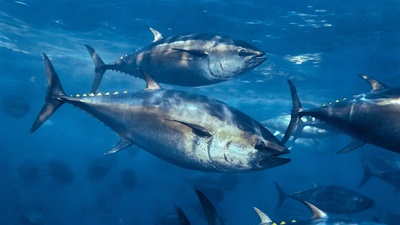Science-Based Fisheries Management Works, U.N. Report Shows
Success with tuna stocks should serve as model for the many fish populations still struggling

Last month, the Food and Agriculture Organization (FAO) of the United Nations released a report that, despite some increasingly bad news, still offered hope for the world’s fisheries. In my 15 years working on international fisheries conservation for The Pew Charitable Trusts, my colleagues and I have maintained that science-based management and strong oversight could bring valuable fish populations back from the brink of collapse and could offer a brighter future for the ocean and the people that depend on these fish for their food and livelihoods.
The 2025 report, which the FAO called its most detailed global assessment of marine fisheries ever, evaluated the sustainability of more than 2,500 fish stocks. For the most part, the news is concerning. As of 2021, more than 35 per cent of all stocks are overfished – a percentage that has increased annually in recent years. Among other things, this means that governments are far from achieving the U.N. Sustainable Development Goal 14, which aimed to end overfishing through effective management by 2020. Despite this, the report gives me reason for optimism. It highlights that major improvements to tuna fisheries management have helped many of those overfished species begin to rebound. This success offers a clear model that managers elsewhere could replicate to recover and protect other fisheries.
Decades of tuna mismanagement nears an end
I’ve spent much of my career in global tuna conservation, so these results are heartening. Today, 87 per cent of tuna and tuna-like species (including mackerel and wahoo) are sustainable, per the FAO – a remarkable statistic given the long history of overfishing and illegal fishing for many tunas and the fact that numerous tuna species rank among the most widely eaten proteins in the world.
For decades, the five tuna-focused regional fisheries management organizations (RFMOs) that govern these species in international waters did not regularly fulfill their mandate to sustainably manage tuna stocks. These RFMOs are responsible for more than $40 billion worth of tuna catch annually, and many RFMOs set catch limits and other measures based more on fishing industry pressure than on sound fisheries science.
In the 1990s and early 2000s, high consumer demand led to severe overfishing in many tuna fisheries, with RFMOs often authorizing catch levels above what scientists advise. This led to the near collapse of Atlantic, Pacific, and southern bluefin tuna populations. Illegal, unreported and unregulated fishing was also rampant, particularly in Mediterranean waters.
How tuna populations are rebuilding
When I started working on tuna fisheries, my team and I had a short-term objective: Stop government-sanctioned overfishing by advocating for science-based catch levels that would rebuild depleted focused populations.
It took years, but eventually RFMOs couldn’t ignore the pressure to act. They implemented science-based recovery plans for overfished stocks and soon saw the results: Pacific bluefin, for example, has grown from 2 per cent of its unfished size to 20 per cent over 10 years, and as the FAO report shows, other populations have also rebounded.
But to ensure sustainability, these success stories need long-term planning – specifically, a management approach known as harvest strategies. These rules center long-term objectives, such as ensuring a species can fulfill its role in a healthy ecosystem as predator, prey and more. Unlike traditional fisheries management, which focuses mostly on commercial fishers’ annual revenue, harvest strategies have flexibility baked in so that, for example, catch limits can rise if a species is healthy or, if it’s not, be cut back until the population recovers.
In another promising sign, RFMOs have started to institute a series of tracking, compliance and enforcement measures that add up to real change. For example, in the Atlantic, an electronic catch documentation scheme for bluefin makes it easier to track fish from the time they are caught to the time they are sold, closing loopholes that have allowed nefarious actors to commit fraud. Tuna RFMOs have also begun to embrace the concept of electronic monitoring on fishing vessels, which augments onboard human observers to help deter illicit activities, although much wider implementation of this technology is still needed. Similarly, many RFMOs have adopted or updated their port controls to align with the Port State Measures Agreement, a U.N. treaty intended to discourage illegal fishing by preventing that catch from reaching the marketplace.
According to the FAO report, “commitment to effective fisheries management – the application of science-based policies, regulatory measures, and compliance systems – has ensured the sustainability of marine fisheries and the benefits they provide.” By adopting smart policies and holding their member countries accountable to good governance, some RFMOs have begun to transform their management.
Now, it’s up to governments to apply the lessons of tuna management to the hundreds of global fisheries that remain in decline. The payoff is clear. By following the science and ensuring that rules are enforced, fisheries managers can help depleted populations rebuild and recover – and perhaps one day soon, meet the U.N. goal of global fisheries sustainability.
Rachel Hopkins directs The Pew Charitable Trusts’ international fisheries and seaweed farming projects.







